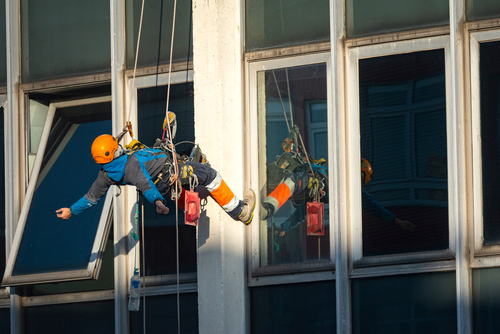Suspension Trauma
The risk of serious injury or death doesn’t end after a construction worker’s fall has been arrested. Although personal protective equipment (PPE) may prevent ground impact, it may leave you or your co-workers vulnerable to the harmful effects of suspension trauma, also known as orthostatic intolerance or harness hang syndrome.
Suspension trauma can occur due to a natural physiological reaction when someone remains upright while unable to stand. As a construction worker, it is crucial to be familiar with its signs and symptoms as well as how to help prevent negative outcomes.
What is Suspension Trauma?
Fall PPE typically includes a harness and lanyard attached to an anchor point. If this type of system arrests your fall, you are often left suspended in an upright position, with you legs dangling and partially immobile.
This vertical orientation and inability to contract your leg muscles, combined with the pressure on your veins from you harness, can result in blood pooling in your lower extremities instead of recirculating. With reduced circulation, your brain and vital organs may be deprived of oxygenated blood, which can lead to unconsciousness, organ damage or death in a matter of minutes. That is why reacting quickly and utilizing suspension trauma prevention strategies is essential.
Suspension Trauma Prevention
There are types of equipment and techniques that can be utilized to help prepare for and prevent suspension trauma injuries and fatalities, including:
- Trauma relief straps – These devices are attached to safety harnesses and can be deployed after a fall is arrested. When uncoiled, they make a loop to press your legs against and simulate standing. This results in leg muscle contractions and pressure relief which can improve blood circulation.
- Fall rescue plans – Comprehensive fall rescue plans are a job site necessity, so it’s important to be familiar with them in case you need to use the information. These plans should include detailed procedures for reacting swiftly after a fall. For example, plans should outline steps for a prompt rescue, including the following types:
- Self-rescue (e.g., when a suspended worker can safely lower themselves to the ground)
- Assisted rescue (e.g., when a rescue worker help retrieve a suspended worker)
Plans should address both when the suspended worker can assist rescue workers and when the suspended worker cannot assist in their rescue. This may be due to a lack of equipment or unconsciousness.
Additionally, fall rescue plans should describe the types and amount of rescue equipment available, how and when to use it, and locations. They should include contact information for key personnel, authorized rescuers, safety managers, nearby hospitals, first responders and OSHA.
- Training – Regularly participating in and understanding training about suspension trauma is an essential safety measure. Training should cover various topics, including:
- An overview of suspension trauma, including what it is, how it occurs and how to recognize it
- The risks associated with suspension trauma and the importance of rescuing workers as quickly as possible
- Factors that increase the risks of experiencing suspension trauma (e.g., environmental conditions and if a worker suffers and injury during the fall)
- Identification of fall hazards at a job site
- Proper use of fall PPE
- Fall rescue plans and how to reduce risks when suspended while wearing fall PPE (e.g., pumping legs to improve circulation and utilizing trauma relief straps)
Additionally, training can provide rescuers with information on how to keep an unconscious worker’s airway open and treat and monitor the person after a rescue since the effects of the event may not be immediately detectable.
Conclusion
Suspension trauma presents a serious risk that threatens health and safety. By following OSHA regulations, reacting quickly and utilizing suspension trauma prevention equipment and techniques, you can help keep yourself and your co-workers safe after falls.
Workers’ Compensation from CoverEase
With the proper workplace safety plan in place, you can minimize the severity and cost of workers’ compensation claims. You may also be able to reduce your workers’ comp costs. Learn more about the cost of workers’ compensation. Get a quote today for workers’ compensation. If you prefer to speak to one of our insurance specialists, please call 888-611-3273.
